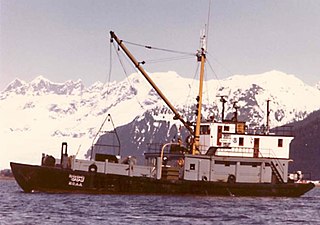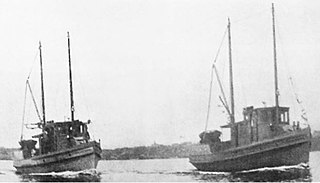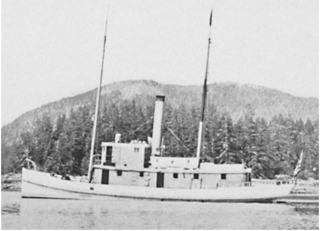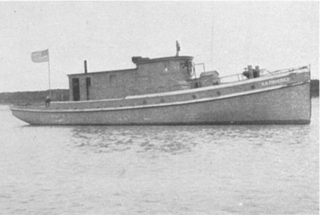
The United States Fish and Wildlife Service is an agency within the United States Department of the Interior dedicated to the management of fish, wildlife, and natural habitats. The mission of the agency is "working with others to conserve, protect, and enhance fish, wildlife, plants and their habitats for the continuing benefit of the American people."

The City and Borough of Juneau, more commonly known simply as Juneau, is the capital city of the U.S. state of Alaska. Located in the Gastineau Channel and the Alaskan panhandle, it is a consolidated city-borough and the second-largest city in the United States by area. Juneau was named the capital of Alaska in 1906, when the government of what was then the District of Alaska was moved from Sitka as dictated by the U.S. Congress in 1900. The municipality unified on July 1, 1970, when the city of Juneau merged with the city of Douglas and the surrounding Greater Juneau Borough to form the current municipality, which is larger by area than both Rhode Island and Delaware.

The University of Alaska Southeast is a public university with its main campus in Juneau, Alaska and extended campuses in Sitka and Ketchikan. It is part of the University of Alaska System and was established on July 1, 1987, with the restructuring and consolidation of the former University of Alaska Juneau, Ketchikan Community College, and Islands Community College (Sitka). The university is accredited by the Northwest Commission on Colleges and Universities.

The United States Fish Commission, formally known as the United States Commission of Fish and Fisheries, was an agency of the United States government created in 1871 to investigate, promote, and preserve the fisheries of the United States. In 1903, it was reorganized as the United States Bureau of Fisheries, sometimes referred to as the United States Fisheries Service, which operated until 1940. In 1940, the Bureau of Fisheries was abolished when its personnel and facilities became part of the newly created Fish and Wildlife Service, under the United States Department of the Interior.

NOAA Ship John N. Cobb was a National Oceanic and Atmospheric Administration research vessel in commission from 1970 to 2008. She was named for John Nathan Cobb and was the oldest commissioned ship in the NOAA fleet when she was decommissioned, having previously served in the United States Department of the Interior′s Fish and Wildlife Service from 1950 to 1956 and in the United States Fish and Wildlife Service′s Bureau of Commercial Fisheries from 1956 to 1970 as US FWS John N. Cobb.

USS Edithena was a United States Navy patrol vessel in commission from 1917 to 1919 that saw service during World War I. Prior to her U.S. Navy service, she operated as the private motor yacht Edithena from 1914 to 1917. After the conclusion World War I, she served as the fishery patrol vessel USFS Widgeon in the fleet of the United States Bureau of Fisheries from 1919 to 1940 and as US FWS Widgeon in the fleet of the Fish and Wildlife Service from 1940 to 1942. During World War II, she returned to U.S. Navy service from 1942 to 1944 as the yard patrol boat USS YP-200. By 1947 she had returned to private ownership, first as Edithena and during the 1970s and 1980s as the fishing vessel Ila Mae.

USS Raeo (SP-588) was a United States Navy patrol vessel in commission from 1917 to 1919. Prior to her U.S. Navy service, she operated as the motor passenger vessel Raeo from 1908 to 1917. After the conclusion of her U.S. Navy career, she served as the fishery patrol vessel USFS Kittiwake in the United States Bureau of Fisheries fleet from 1919 to 1940 and as US FWS Kittiwake in the Fish and Wildlife Service fleet from 1940 to 1942 and from 1944 to at least 1945, and perhaps as late as 1948. During World War II, she again served in the U.S. Navy, this time as the yard patrol boat USS YP-199. She was the civilian fishing vessel Raeo from 1948 to 1957, then operated in various roles as Harbor Queen from 1957 to 1997. She became Entiat Princess in 1998 and as of 2009 was still in service.

USCGC Liberty (WPB-1334) is an Island-class cutter of the United States Coast Guard. She spent her first 33 years of service homeported in Juneau, Alaska where she patrolled territorial waters, including the Inside Passage. In 2016 she won the Hopley Yeaton Cutter Excellence Award for outstanding operational and humanitarian achievements. In 2022 she was reassigned to Valdez, Alaska.

NOAAS Oregon, previously NOAAS Oregon, was an American fisheries research vessel in commission in the National Oceanic and Atmospheric Administration (NOAA) fleet from 1970 to 1980. Prior to her NOAA career, she operated under the United States Fish and Wildlife Service from 1949 to 1970 as US FWS Oregon.

NOAAS Murre II, previously NOAAS Murre II, was an American research vessel in commission in the National Oceanic and Atmospheric Administration (NOAA) fleet from 1970 to 1989. Prior to her NOAA career, she operated under the United States Department of the Interior′s Fish and Wildlife Service from 1949 to 1956 and under the United States Fish and Wildlife Service′s Bureau of Commercial Fisheries from 1956 to 1970 as Murre II.

USFS Penguin was an American cargo liner in commission in the fleet of the United States Bureau of Fisheries from 1930 to 1940 and, as US FWS Penguin, in the fleet of the U.S. Fish and Wildlife Service from 1940 to 1950. She ran a passenger-cargo service between Seattle, Washington, and the Pribilof Islands, and provided transportation between the two inhabited Pribilofs, Saint Paul Island and St. George Island. She also carried passengers, supplies, and provisions to destinations on the mainland of the Territory of Alaska and in the Aleutian Islands. She occasionally supported research activities in Alaskan waters and the North Pacific Ocean.

USFS Eider was an American motor schooner in commission in the fleet of the United States Bureau of Fisheries from 1919 to 1940 and, as US FWS Eider, in the fleet of the U.S. Fish and Wildlife Service from 1940 to 1942 and again in the late 1940s. She ran a passenger-cargo service between Unalaska and the Pribilof Islands, and also carried passengers, supplies, and provisions to destinations on the mainland of the Territory of Alaska and in the Aleutian Islands. She occasionally supported research activities in Alaskan waters and the North Pacific Ocean, and she conducted patrols to protect Alaskan fisheries and marine mammals. In 1924, she provided logistical support to the first aerial circumnavigation of the world.

MV Brown Bear was an American research vessel in commission in the fleet of the United States Department of Agriculture′s Bureau of Biological Survey and Alaska Game Commission from 1934 to 1940 and in the fleet of the United States Department of the Interior′s Fish and Wildlife Service from 1940 to 1942 and from 1946 to 1951, under the control of the University of Washington from 1952 to 1965, and in commission in the fleet of the United States Fish and Wildlife Service from 1965 to 1970 and of the National Oceanic and Atmospheric Administration′s National Marine Fisheries Service (NMFS) from 1970 to 1972.

USFS Auklet was an American fishery patrol vessel that served in the waters of Southeast Alaska. She was in commission in the United States Bureau of Fisheries from 1917 to 1940 and in the U.S. Fish and Wildlife Service as US FWS Auklet from 1940 to 1950.

USFS Murre was an American fishery patrol vessel that served in the waters of Southeast Alaska. She was in commission in the United States Bureau of Fisheries fleet from 1917 to 1940 and, as US FWS Murre in the U.S. Fish and Wildlife Service fleet from 1940 to 1942. Murre and her sister ship USFS Auklet were the first vessels ever constructed for fisheries enforcement duties in Alaska.

USFS Osprey was an American steamer that served as a fishery patrol vessel in the waters of the Territory of Alaska. She was in commission in the United States Bureau of Fisheries (BOF) from 1913 to 1921, and was the first vessel the BOF ever operated on fishery patrols in Alaska. Before the BOF purchased her, she was the commercial cannery tender Wigwam from 1895 to 1912. After her BOF career ended, she operated as a commercial motor tug with the name Foss No. 19 from 1922 to 1965 and with the name Kiowa from 1965 until she sank in 1978.

USFS Teal was an American fishery patrol vessel that operated in the waters of the Territory of Alaska. She was part of the fleet of the United States Bureau of Fisheries (BOF) fleet from 1928 to 1940. She then served as US FWS Teal in the fleet of the Fish and Wildlife Service from 1940 to 1960. After a stint in the fleet of the Alaska Department of Fish and Game from 1960 to 1966, she was sold into private service, and remained in operation as of 2016.

USFS Scoter was an American fishery patrol vessel that operated in the waters of the Territory of Alaska. She was part of the United States Bureau of Fisheries (BOF) fleet from 1922 to 1940. She then served as US FWS Scoter in the fleet of the Fish and Wildlife Service from 1940 to 1950. Before her United States Government service, she was the commercial purse seiner Clatsop. She returned to that name and to private ownership after the conclusion of her U.S. Government career.

USFS Brant was an American fishery patrol vessel that operated in the waters of the Territory of Alaska and off Washington, California, and Mexico. She was part of the United States Bureau of Fisheries (BOF) fleet from 1926 to 1940. She then served as US FWS Brant in the fleet of the Fish and Wildlife Service from 1940 to 1953. She then operated commercially until she sank in 1960.

USFS Pelican was an American fisheries science research ship and fishery patrol vessel that operated along the United States East Coast and the United States Gulf Coast and in the waters of the Territory of Alaska. She was part of the United States Bureau of Fisheries (BOF) fleet from 1930 to 1940. She then served as US FWS Pelican in the fleet of the Fish and Wildlife Service – from 1956 the United States Fish and Wildlife Service – from 1940 to 1958. She served as a fishery patrol vessel while on loan to the Washington Department of Fish and Wildlife from 1958 to 1970, then briefly returned to the Fish and Wildlife Service's successor agency, the National Marine Fisheries Service. Her United States Government service ended when she was sold into private hands in 1972, and she remained extant as of 2010. In 2017 Captain Patrick Burns and Captain John (Johnny) Sylvester purchased the Pelican from Marilyn Masland. She is currently moored in Deer Harbor on Orcas Island, WA. In 2018 she was brought up the Inside Passage to Alaska and back to Washington.





















